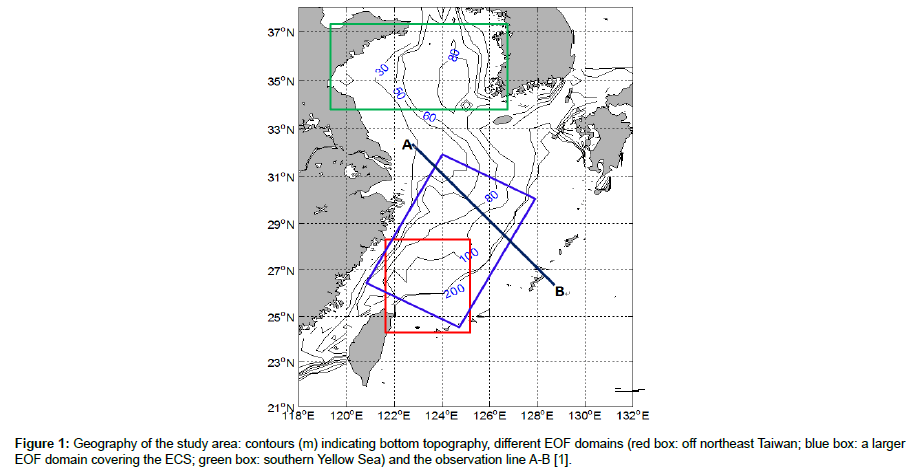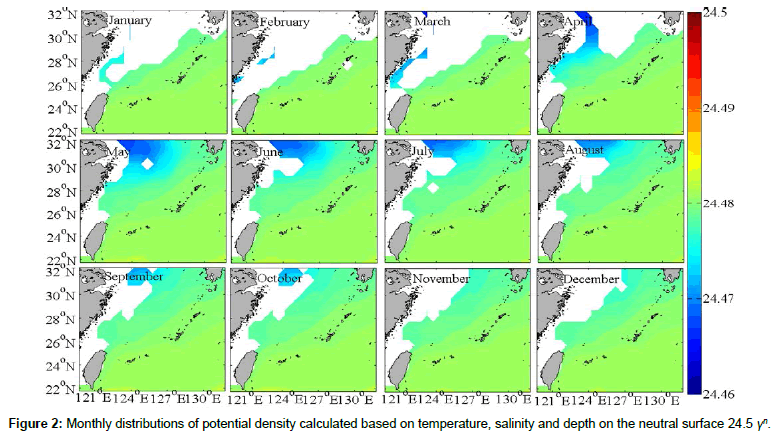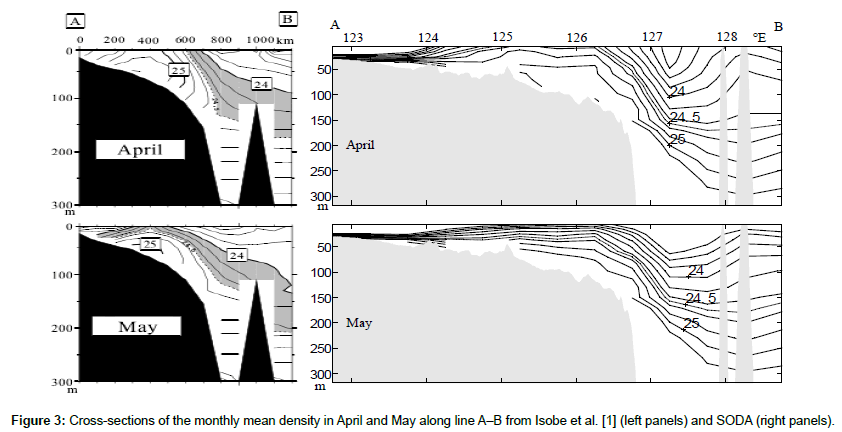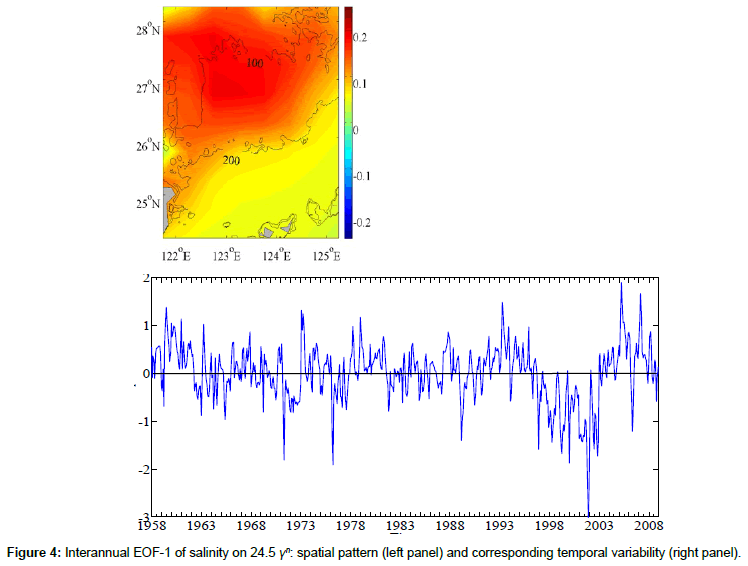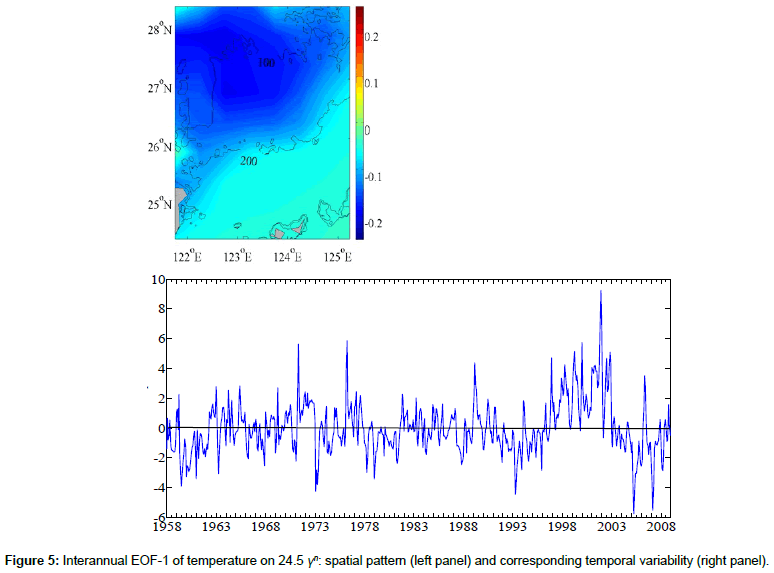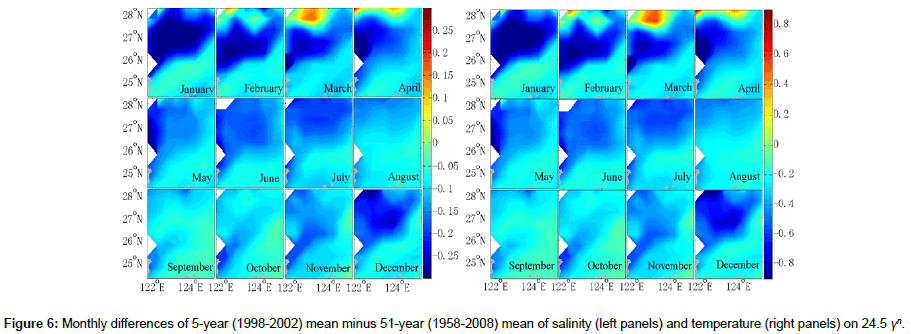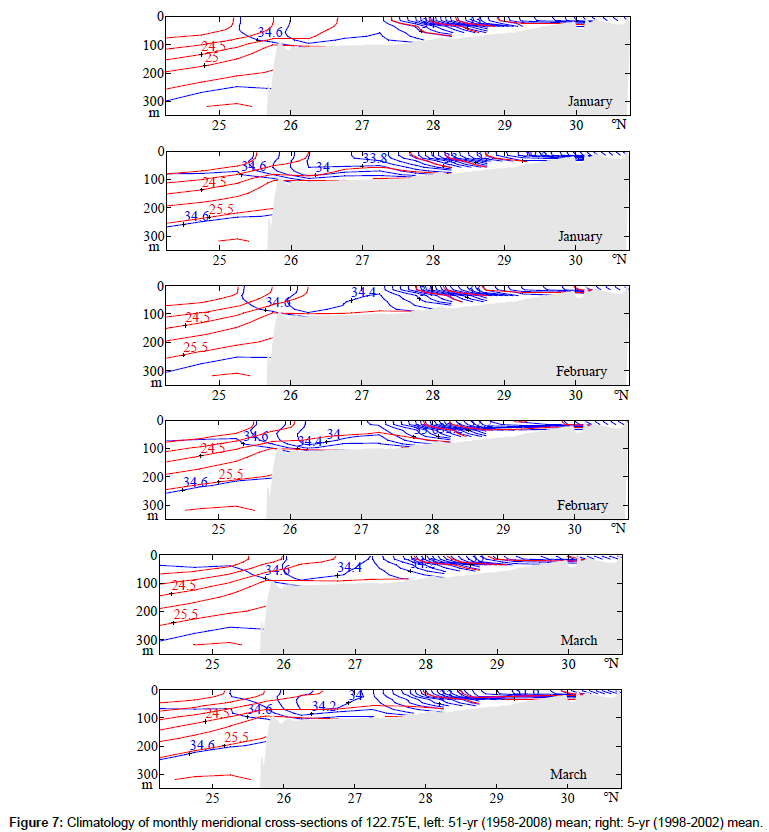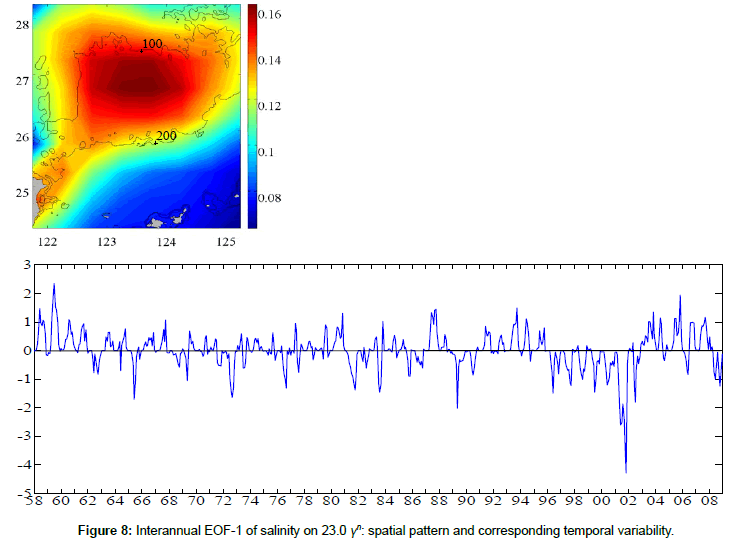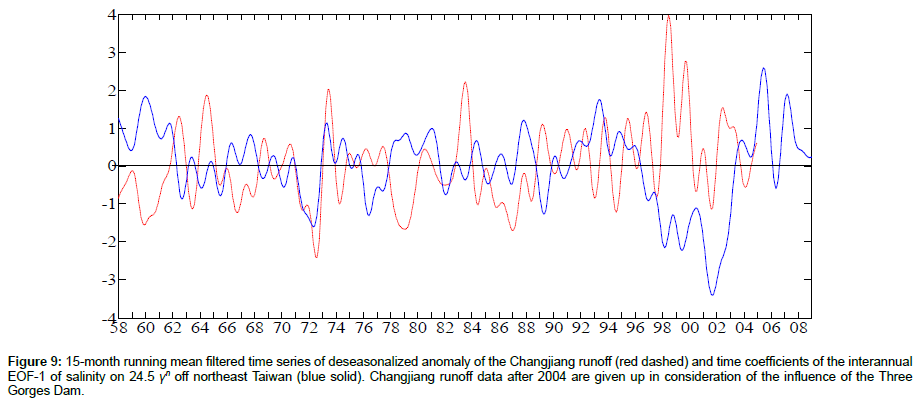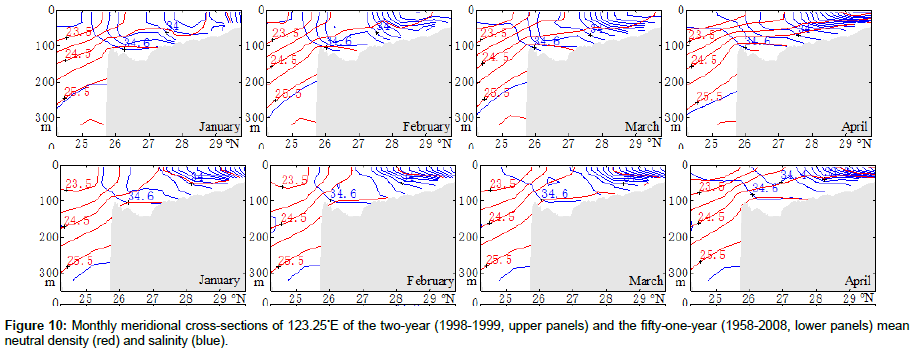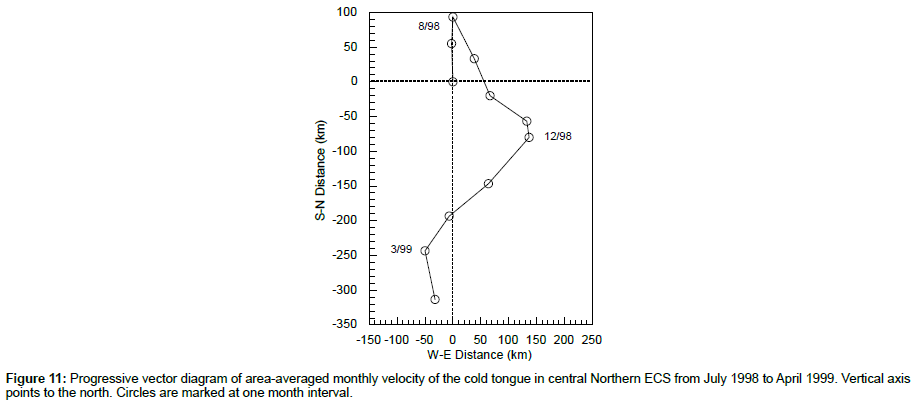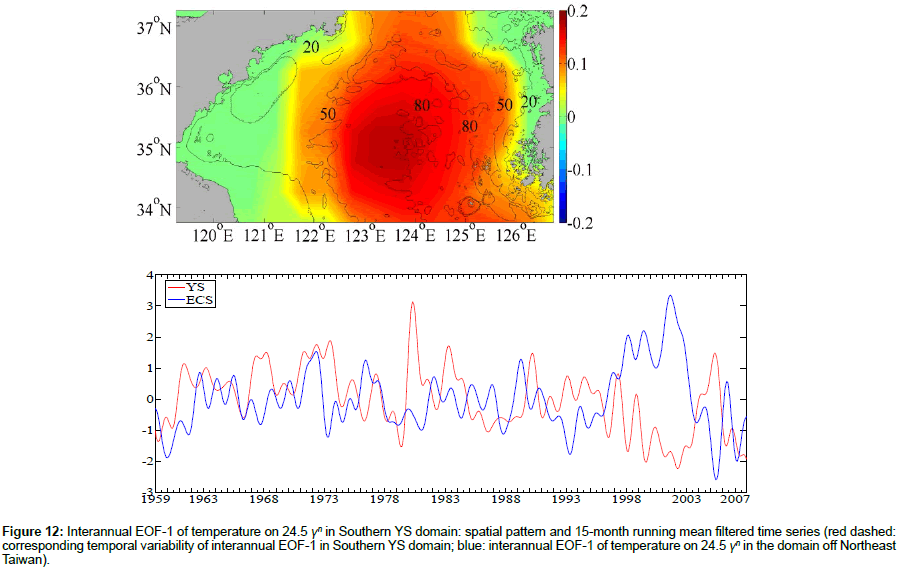Research Article, J Mar Biol Oceanogr Vol: 6 Issue: 3
Interannual Variability of Subsurface Intrusion of Low-Temperature and Salinity Shelf Water into the Kuroshio in the East China Sea
Peng Qi1,2* and Yun-Xia Guo1,2,3
1Institute of Oceanology, Chinese Academy of Sciences, Qingdao 266071, China
2Key Laboratory of Ocean Circulation and Waves, Chinese Academy of Sciences, Qingdao 266071, China
3University of Chinese Academy of Sciences, Beijing 100049, China
*Corresponding Author : Peng Qi
Key Laboratory of Ocean Circulation and Waves, Institute of Oceanology, Chinese Academy of Sciences, 7 Nanhai Road, Qingdao 266071, China
Tel: +86-532-82898550
E-mail: pqi@qdio.ac.cn
Received: June 30, 2017 Accepted: July 31, 2017 Published: August 07, 2017
Citation: Qi P, Guo Y (2017) Interannual Variability of Subsurface Intrusion of Low-Temperature and Salinity Shelf Water into the Kuroshio in the East China Sea. J Mar Biol Oceanogr 6:3. doi: 10.4172/2324-8661.1000182
Abstract
Interannual Variability of Subsurface Intrusion of Low- Temperature and Salinity Shelf Water into the Kuroshio in the East China Sea
Spatiotemporal characteristics of salinity and temperature on isopycnal surfaces and subsurface exchange of Kuroshio and ECS shelf water are investigated based on Simple Ocean Data Assimilation (SODA) reanalysis data from January 1958 to December 2008. Applying a neutral density variable γn and Empirical Orthogonal Function (EOF) analysis, dominant spatial features and corresponding temporal variability on both seasonal and interannual time scales are revealed on neutral surfaces 23.0-24.5 γn. The most remarkable characteristic of variability on interannual time scale is the anomalous strengthening of subsurface intrusion of less saline shelf water into the shelf edge and the Kuroshio region during strong La Niña years. Possible causes inducing the strengthening are found to be associated with extraordinarily large discharge of the Changjiang in the following years of strong El Niño as well as the variability of the Yellow Sea bottom cold water modulated by La Niña Events.
Keywords: Kuroshio; East China Sea shelf water; Subsurface intrusion; Interannual variability; Changjiang discharge; Yellow Sea cold water mass
Introduction
When the Kuroshio flows through the East China Sea (ECS), it exchanges extensively with ECS shelf water. Part of the saline Kuroshio water intrudes onto the shallow shelf of ECS. Meanwhile, part of the less saline shelf water leaks to the subsurface layer of the Kuroshio region [1]. There has been some observational evidence of the intrusion of less saline shelf water. Based on a hydrographic observation in November 1996, Matsuno and Ohsaki [2] and Matsuno et al. [3] found that the shelf water with salinity less than 34.3 psu extends toward the Kuroshio region between 50 and 100 m depths. Based on CTD/ADCP observations in May 1998–2001, Isobe et al. [1] found subsurface intrusions of less saline shelf water into the Kuroshio region at the shelf break and suggested the subsurface intrusion is always detected in May in layers above the isopycnal 24.5 σθ. Luckily, their in-situ observational periods happened to be in the following years of the strongest 1997/98 El Niño. However, interannual variability was not mentioned. What is the interannual variability of the subsurface intrusion? No one has touched upon it yet. On possible origins of the less saline shelf water, Gao et al. [4] indicated that the less saline water in the Yellow and East China Seas is derived mainly from the Yangtze River (Changjiang). Zhu et al. [5] suggested that Changjiang runoff has an effect on the trend of southeast expansion of Changjiang Diluted Water (CDW). Isobe et al. [1] guessed that CDW plume extends eastward and encounters outcropping isopycnals, and the freshwater is subducted into the isopycnals, and carried toward the Kuroshio frontal region around the shelf edge. However, there has been still a lack of related evidences to confirm the inference.
In this study we describe the spatiotemporal characteristics of salinity and temperature on isopycnal surfaces in the southern ECS and focus on seasonal cycle and interannual variability in the subsurface exchange of the Kuroshio and the ECS shelf water, based on more reliable reanalysis data. Our analyses also suggest an interannually strengthening of the subsurface intrusion of less saline shelf water toward the Kuroshio frontal region around the shelf edge.
Data, Methods, and Validations
We use long series (1958−2008) of monthly averaged gridded salinity, temperature and pressure data from SODA v2.1.6 [6], the most recent released version. The ocean model based on Parallel Ocean Program physics is run with observations containing all kinds of observation data.
We use a practical method called neutral density for the subsurface study. This method is based on a neutral density variable γn, which is not only a function of the three state variables: salinity, temperature, and pressure, but also of longitude and latitude [7]. Unlike discretely referenced potential density surfaces, neutral density surfaces are continuous and of the most appropriate surfaces.
Empirical orthogonal function (EOF) decomposition is applied to extract a small number of principle components to explain most of the dominant variations of certain dataset. To highlight interannual variability, we filter out the annual signal by subtracting the 51-year (1958-2008) average from January to December from the data set, and obtain a deseasonalized data set and calculate EOFs. These EOFs reflect the interannual variability and are named interannual EOFs. Different EOF domains considered in this paper are shown in Figure 1.
Figure 1: Geography of the study area: contours (m) indicating bottom topography, different EOF domains (red box: off northeast Taiwan; blue box: a larger EOF domain covering the ECS; green box: southern Yellow Sea) and the observation line A-B [1].
We use the computational algorithm given by Jackett and McDougall [7] for evaluating γn. First of all, the reliability of the neutral density method needs to be tested. Using salinity, temperature, and pressure, we re-calculate the potential density on the neutral surface γn = 24.5 kg/m3, where γn denotes the neutral density. Monthly mean values of the potential density from January to December are shown in Figure 2, which are around 24.48 very close to the default value 24.5 in the most study area. So we consider the method provided by Jackett and McDougall [7] as a reliable one for density surface.
The use of SODA data in this study is validated by comparing with observations in Isobe et al. [1]. Figure 3 shows cross-sections of the density averaged in April and May along the line A-B (from (123°E, 32°N) to (129°E, 26°N), Isobe et al. [1]. The left panels are from Isobe et al. [1], which are of the potential density based on a dataset archived by Japan Oceanographic Data Center, and the right panels are our neutral density calculations based on SODA data. It is easily seen that they have roughly the same density distribution characteristics, particularly isopycnal surfaces 24.5 γn or less outcropping to the sea surface in April, but not in May. This means that the isopycnal surface 24.5 γn is the deepest layer of outcropping to the sea surface over the shallow shelf in early spring. We reach the same conclusion as Isobe et al. [1], who believed the density surface 24.5 is the deepest layer of the Kuroshio pycnocline outcropping to the sea surface in early spring. Cross-sections of the density and salinity in May 1998 along the observation line A [1] are also compared between our calculations with SODA and the observations by Isobe et al. [1]. Similar distributions are obtained.
Figure 3: Cross-sections of the monthly mean density in April and May along line A–B from Isobe et al. [1] (left panels) and SODA (right panels).
EOF Results
On neutral density surface 24.5 γn
The EOF domain (121.75°E125.25°E, 24.25°N−28.25°N, red box in Figure 1) off northeast Taiwan is selected covering the southern shelf and Kuroshio. Temperature and salinity fields on neutral surface 24.5 γn are first calculated. Multi-year mean of each month from January to December are then calculated and removed from the temperature and salinity fields. Finally, EOF decomposition is applied to the residual data (interannual anomaly series).
The first Interannual EOF of salinity and temperature accounts for 39.5% and 38.4% of the total variance, respectively. They both pass the significant test [8] which suggests that these first interannual modes have statistical meanings. The spatial and temporal modes for salinity and temperature are shown in Figure 4 and Figure 5, respectively. Obvious interannual oscillations can be seen in these temporal amplitude series. The running mean filter with a window of 15 months was applied to the temporal variability to allow comparison with Changjiang runoff anomaly and save space. We focus on the period 1998-2002. Combining the positive spatial phase and the negative temporal amplitude in Figure 4, and the negative spatial phase and the positive temporal amplitude in Figure 5, a significant negative anomaly of salinity and temperature, or less saline cold water, exists stably on the 24.5 γn over the outer shelf in southern ECS.
The above EOFs are aimed at anomalies. It is necessary to compare the mean fields of the five-year (1998-2002) and the climatology (1958-2008) on 24.5 γn. Differences between them (the former minus the latter) are shown in Figure 6. On 24.5 γn, from the outer shelf to the shelf edge, significant low-salinity and low-temperature water occurs in the corresponding area of the interannual EOF-1, especially in winter and spring.
Figure 7 shows monthly meridional cross-sections of 122.75°E. For comparison, the 5-year (1998-1999) mean and the 51-year (1958- 2008) mean neutral density and salinity are plotted in right and left panels, respectively. For the 5-year mean salinity, contours of 34.2 psu or less expand significantly to the shelf edge, which indicate that low-salinity shelf water may penetrate into the subsurface layer of the Kuroshio during winters and early springs 1998-2002.
Based on CTD/ADCP observations in May 1998-2001, Isobe et al. [1] found subsurface intrusions of the less saline shelf water on 24.5 σθ into the Kuroshio region in the ECS. Their in-situ observational periods happened to be in the following years of the strongest 1997/98 El Niño. Based on SODA data, we examined the interannual variability of subsurface intrusion of less saline shelf water and found the strengthening in response to strong La Niña years.
On other neutral surfaces and in a larger EOF domain
Our EOF analysis is also applied to other neutral surfaces above 24.5 γn. We obtained almost the same spatial and temporal characteristics on those surfaces. For example, the interannual EOF- 1 on 23.0 γn, explaining 48.1% of the total variance, is characterized by interannual variability, especially an unusually significant negative anomaly of salinity in the corresponding area in the period 1998-2002 (Figure 8). Considering that EOF results are sensitive to domain size, EOF domain is also reset to a larger one covering almost the entire ECS shelf including close to CDW plume area and northern ECS. We found low-salinity water area exists stably mainly over the southern shelf of ECS, but the percentage explaining the total variance reduces due to enlarged EOF domain.
Possible Causes of Strengthening of Subsurface Intrusion of Less Saline Shelf Water
Extraordinarily large discharge of Changjiang in the following years of strong El Niño
Less saline shelf water in the Yellow and East China Seas is derived mainly from Changjiang [1,4]. Freshwater supply from Changjiang increases in spring [9,10]. Figure 9 shows 15-month running mean filtered time series of deseasonalized anomaly of 45- year (1959-2003) Changjiang runoff at Datong Station, together with the temporal variability of interannual EOF-1 of salinity. The correlation coefficient of the two curves is –0.32, which is statistically significant at the confidence level 99%. It is easily seen that the lowsalinity performance of interannual EOF-1 is closely corresponding to the extraordinarily large discharge of Changjiang in 1998-1999. However, the corresponding relationship between the two is not good in 2000 and 2001.
Figure 9: 15-month running mean filtered time series of deseasonalized anomaly of the Changjiang runoff (red dashed) and time coefficients of the interannual EOF-1 of salinity on 24.5 γn off northeast Taiwan (blue solid). Changjiang runoff data after 2004 are given up in consideration of the influence of the Three Gorges Dam.
Outcropping locations of isopycnal surface expanding further to the north
24.5 γn is a critical isopycnal surface because it is the deepest layer of the Kuroshio pycnocline outcropping to the sea surface on the shallow shelf in early spring. Isobe et al. [1] guess that less saline shelf water subducting along the isopycnal surface origins from Changjiang plume. Figure 4 shows monthly meridional crosssections of 123.25°E. For comparison, the two-year (1998-1999) mean and the fifty-one-year (1958-2008) mean neutral density and salinity are plotted in the upper and lower panels, respectively (Figure 10). It is easily seen that from January to March the outcropping location of isopycnal 24.5 γn of the two-year mean expands further to the north than climatology. Meanwhile, we notice the low-salinity center on the shelf overlies the 24.5 γn due to its expanding further to the north (upper panels). The outcropping 24.5 γn and the overlying less saline shelf water encounters and contacts fully in early spring. This situation paves the way for subduction of low-salinity shelf water along the isopycnal surface (24.5 γn).
La Niña events modulate variability of YSBCW
The period when subsurface intrusion of less saline shelf water in ECS are anomalously strengthened lasts five years (1998-2002), while the period when Changjiang supplies extraordinarily large discharge is only two years (1998-1999). What is the cause for another three years’ strengthening? This suggests that besides the Changjiang discharge, there should be other possible origins for less saline and cold shelf water. We think of the Yellow Sea near bottom cold water (YSBCW) which adjoins the Northern ECS.
The Yellow Sea (YS) is a shallow inland sea lying between Northeastern China and the Korean Peninsula, with depths in its central trough in excess of 60 to 80m. The central trough extends from north to south and southeast with the depth gradually increasing and the deepest area over 100m around the Jeju Island, and then in connection with the ECS. By analyzing GDEM (Generalized Digital Environmental Model) data from U.S. navy, Yu et al. [11] indicated that the bottom cold water in central Northern ECS in summer originates from YSBCW. On interannual time scale, Li et al. [12] studied the correlation between winter ENSO indices and YSBCW in summer, and found that La Niña events correspond to larger area and lower temperature of YSBCW. By analyzing nearbottom water in Southern YS and Northern ECS in summer using SODA, we found that near-bottom cold water exists in Southern YS as well as central Northern ECS. They should be one [11]. From the isotherm distribution, there exist two frontal zones around YSBCW, namely, the inner one (enveloping the core of YSBCW) and the outer one (enveloping bottom cold water in central Northern ECS). The bottom cold water area in central Northern ECS is a semi-closed cold tongue centered at 124.2°E, 31.5°N with temperature less than 14.0°C according to SODA. Around the rim of the cold tongue (isotherm 14.0°C), horizontal temperature gradient is strong, rather than around the core of YSBCW.
We further calculated the area-averaged monthly velocity of the cold tongue in central Northern ECS. The general trend of a vector time series can be best shown on the progressive vector diagram, and those of July 1998−April 1999 currents are plotted in Figure 11. The mean flow is toward southeast in September−December 1998, and southwest in January−March 1999.
On the other hand, by applying EOF analysis to salinity and temperature anomalies on 24.5 γn in Southern YS domain [119.25°E−126.75°E, 33.75°N−37.25°N] respectively, we discovered that the first interannual EOF for both salinity and temperature (Figure 12) is characterized by significant interannual variability, especially strengthening of less saline and cold water during 1998- 2002. In Figure 12, 15-month running means filtered time series of interannual EOF-1 of Southern YS domain is from April 1958 to March 2007, while that of the domain off Northeast Taiwan is from January 1959 to December 2007. That is, the latter lags behind the former nine months. We also found that the negative correlation between the two curves reaches the highest (−0.30, which is statistically significant at the confidence level 99%) when the interannual EOF-1 of the domain off Northeast Taiwan lags behind nine months.
Figure 12: Interannual EOF-1 of temperature on 24.5 γn in Southern YS domain: spatial pattern and 15-month running mean filtered time series (red dashed: corresponding temporal variability of interannual EOF-1 in Southern YS domain; blue: interannual EOF-1 of temperature on 24.5 γn in the domain off Northeast Taiwan).
In summary, we infer that the cold tongue area in central Northern ECS may be a key region, where bottom cold water slips into the ECS, and is modulated by the variability of YSBCW, the main body of cold water.
Conclusions
The dominant spatial patterns of variability of the subsurface intrusion of less saline shelf and cold water on neutral surfaces in ECS and corresponding temporal evolutions during 1958–2008 are revealed by EOF analysis. The results indicate that annual cycles dominate the first EOF mode both for salinity and temperature, which exhibits a seasonal reversal, less saline and cold shelf water in winter and early spring mainly in the northwest corner of EOF domain off Northeast Taiwan. The second annual EOF is characterized by an interannual cycle, which is mixed with an annual signal. We removed the annual signal from the data set and calculated the interannual EOFs. The first interannual EOF represents the interannual variability existing in the second annual EOF. This means, on an interannual time scale, a significant negative anomaly of salinity or temperature, or the anomalous strengthening of the subsurface intrusion of less saline and cold shelf water into the shelf edge and the Kuroshio region exists stably around the topographic trough of the 100m isobaths during winters and early springs 1998-2002.
Possible causes inducing the strengthening are explored and found to be associated with not only extraordinarily large discharge of the Changjiang in the following years of the strongest El Niño, but also the key region of cold tongue in central Northern ECS, where bottom cold water slips into the ECS, and is modulated by the variability of YSBCW, the main body of cold water, although only Changjiang discharge and its diluted water plume are consider in previous view.
Firstly, as the deepest layer of the Kuroshio pycnocline outcropping to the sea surface on the shallow shelf, the isopycnal 24.5 γn outcrops to the sea surface in early spring. In this season, Changjiang plume extends eastward, and encounters the outcropping isopycnals. The key here is the outcropping location of the isopycnal surface expands further to the north in the following years of the strongest 1997/98 El Niño. Less saline shelf water overlying on the 24.5 γn intrudes into the Kuroshio subsurface around the shelf edge.
However, the period when Changjiang supplies extraordinarily large discharge lasts only two years (1998-1999), which cannot explain the entire period (1998-2002) of the strengthening. We have found another interannual factor, the YSBCW variability modulated by La Niña events. EOF analysis is applies not only in the domain off Northeast Taiwan, but also in the Southern YS domain. Their temporal variabilities of the first leading interannual EOFs are highly correlated with interannual EOF-1 of the domain off Northeast Taiwan ninemonth lag. We found a key region of semi-closed cold tongue centered at 124.2°E, 31.5°N in central Northern ECS, which is one with the YSBCW.
This study proposes a whole new idea to explain the variability of subsurface intrusion of less saline and cold shelf water into the shelf edge and the Kuroshio region in ECS. Correlations of EOF temporal variability between Southern YS domain and Southern ECS domain are revealed. However, further studies are needed to resolve the detail dynamic mechanism of the phenomenon. Research about the interesting phenomenon demonstrated in the study base on a numerical model is underway.
Acknowledgments
This study was supported by the "Strategic Priority Research Program" of the Chinese Academy of Sciences, Grant No. XDA11020101. Data of SODA v2.1.6 were downloaded from the site of Asia Pacific Data Research Centre.
References
- Isobe A, Fujiwara E, Chang PH, Sugimatsu K, Shimizu M, et al. (2004) Intrusion of Less Saline Shelf Water into the Kuroshio Subsurface Layer in the East China Sea. J Oceanogr 60: 853-863.
- Matsuno T, Ohsaki S (1999) Subduction of low salinity water into the intermediate layer of the Kuroshio in the East China Sea. Proceedings CREAMS’99 International Symposium, 64-67.
- Matsuno T, Ohsaki S, Kanari S, Takaki Y, Kuno T (2000) Mixing processes and horizontal intrusion around the shelf break in the East China Sea: Interactions between Estuaries, Coastal Seas and Shelf Seas. Terra Scientific Publishing Co., Tokyo.
- Gao Y, Arimoto R, Duce RA, Lee DS, Zhou M (1992) Input of atmospheric trace elements and mineral matter to the Yellow Sea during the spring of a low-dust year. J Geophys Res 97: 3767-3777.
- Zhu J, Xiao C, Shen H (1998) Numerical model simulation of expansion of Changjiang diluted water in summer. Acta Oceanologica Sinica 20: 13-22.
- http: //apdrc.soest.hawaii.edu/datadoc/soda_2.2.4.php
- Jackett DR, McDougall TJA (1997) Neutral Density Variable for the World’s Oceans. J Phys Oceanogr 27: 237-263.
- Barnett TP (1977) The principal time and space scales of the Pacific trade wind fields. J Atmos Sci 34: 221-236.
- Chen C, Beardsley RC, Limeburner R, Kim K (1994) Comparison of winter and summer hydrographic observations in the Yellow and East China Sea and adjacent Kuroshio during 1986. Cont Shelf Res 14: 909-929.
- Yanagi T (1994) Material transport in the Yellow/East China Seas. Bull Coastal Oceanogr 31: 239-256.
- Yu F, Zhang Z, Diao X, Guo J, Tang Y (2006) Analysis of evolution of the Huanghai Sea cold water mass and its relationship with adjacent water masses. Acta Oceanologica Sinica 28: 26-34.
- Li X, Wang X, Chu P, Zhao D (2015) Low-frequency variability of the Yellow Sea cold water mass identified from the China coastal waters and adjacent seas reanalysis. Adv Meteorol 2015: 269859.
 Spanish
Spanish  Chinese
Chinese  Russian
Russian  German
German  French
French  Japanese
Japanese  Portuguese
Portuguese  Hindi
Hindi 